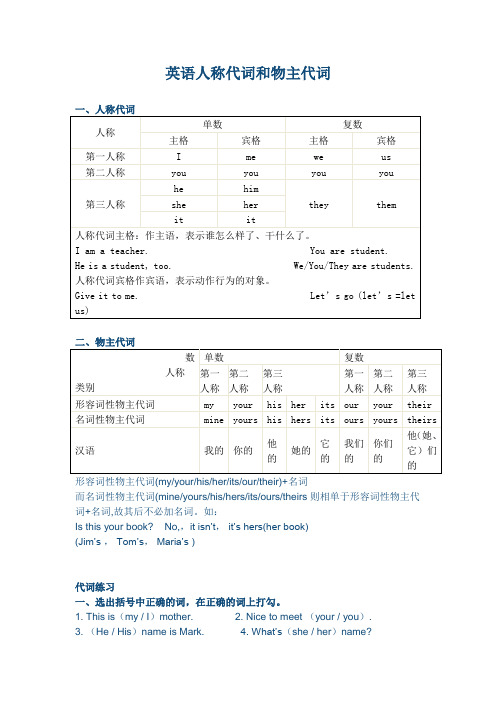英语人称代词和物主代词
- 格式:docx
- 大小:18.36 KB
- 文档页数:3

人称代词和物主代词表人称代词和物主代词是英语中常用的代词类型,以下是它们的表:人称代词:- I (我)- You (你)- He (他)- She (她)- It (它)- We (我们)- You (你们)- They (他们)物主代词:- My (我的)- Your (你的)- His (他的)- Her (她的)- Its (它的)- Our (我们的)- Your (你们的)- Their (他们的)人称代词和物主代词的使用很频繁,以下是一些例句:- I like to eat pizza. (我喜欢吃比萨饼。
)- This is my book. (这是我这本书。
)- Your phone number is 555-1234. (你电话号码是 555-1234。
) - His name is John. (他名字是约翰。
)- Her job is as a teacher. (她工作是一名老师。
)- Its color is blue. (它颜色是蓝色。
)- Our family lives in a big house. (我们家庭住在一所大房子里。
)- Your friends are cute. (你朋友好可爱。
)- Their shoes are on the table. (他们鞋子在桌子上。
) 人称代词和物主代词在语法上起着重要的作用,可以用于主语、宾语等位置。
同时,它们也是英语中最常见的代词类型之一。

人称代词与物主代词的区分一、人称代词:代替某事物名称的代词叫人称代词。
在句子中作主语或宾语。
1、主格的人称代词比如I(第一人称单数),you(第二人称单、复数),he(第三人称男性单数),she(第三人称女性单数),it(第三人称指单数物品、小动物,或用于指婴儿),we(第一人称复数),they(第三人称复数)。
2、宾格的比如me(I的宾格),him(he的宾格),her(she的宾格),us(we的宾格),them(they的宾格)。
其中第二人称you和第三人称it的主宾格形式相同。
人称代词主格作句子的主语,宾格作句子的宾语,例:I like playing tennis.如果这个主语是第三人称单数,即he,she或it,句子的谓语动词要用第三人称单数形式,例:He likes playing tennis. likes的原形是like.二、物主代词:用来表示某人(物)归属于某人(物)所有的代词叫做物主代词。
物主代词分为名词性物主代词和形容词性物主代词。
1.名词性物主代词通常作宾语。
有mine(我的),yours[你(们)的],his(他的),her(她的),its(它的),our(我们的),theirs[他(她,它)们的]等。
2.形容词性物主代词相当于形容词,与形容词的用法相同。
有my(我的),your(你的),his(他的),her(她的),its(它的),their[他(她,它)们的]等。
注意:(1)与形容词一起修饰名词时,放在形容词的前面。
(2)在句中只能用作定语修饰名词,而且后面必须跟名词。
(3)如果名词前用了形容词性物主代词,就不能再用冠词(包括定冠词the和不定冠词a/an)、指示代词(this, that, these, those)等修饰词。
例句:That pencil is my pencil. 那支铅笔是我的铅笔。
That pencil is mine.那支铅笔是我的。
句中的my pencil=mine.人们也更习惯于用名词性物主代词代替前文提到过的、以形容词性物主代词修饰的名词。

5. Excuse(me / my / I).6. Are(your / you)Miss Li?7.(I/ My)am Ben. 8.(She / Her)is my sister.9. Fine , thank (your / you). 10. How old is (he / his)二、用所给代词的正确形式填空。
1. These are ______ ( he ) brothers.2. That is _______( she ) sister.3. Lily is _______ ( Lucy ) sister.4. Tom, this is _____ ( me ) cousin, Mary.5. Now _____________(her parent) are in America.6. Those __________ ( child ) are _____ ( I ) father’s students.7. Do you know ______ ( it ) name?8. Mike and Tom __________ ( be ) friends.9. Thanks for helping ________( I ).10. ______(Ann安)mother is ______(we) teacher.三、单项选择。
()1. My family ____ a big family. My family ____all here.A. is, isB. are, areC. is, areD. are, is()2. This is __________.A. a picture of familyB. a picture of my familyC. a family’s pictureD. a family of my picture()3. Let’s __________ good friends.A. beB. areC. isD. am()4. Is she your aunt? Yes, __________.A. she’sB. her isC. she isD. he is ()5. Are __________ coats yours? Yes, they are .A. theyB. theseC. thisD. there ()6. Is that __________ uncle? No, it isn’tA. heB. sheC. herD. hers()7. Mrs. Green is __________ grandmother.A. Jim and KateB. Jim and Kate’sC. Jim’s and Kate’sD. Jim and Kates’()8. Do you know the name _____Mr. Green’s son?A. inB. ofC. onD. or ()9. __________ the great photo of your family.A. thank forB. Thanks forC. Thank forD. thanks for()10. Are those your friends? __________.A. Yes, they’reB. No, they areC. Yes, they areD. Yes, those are答案:一.my you His her me you I she you he二.1.his 2.her 3.Lucy’s 4.my 5.her parents 6. children my 7. its 8.are 9. me 10.Ann’s our三.CBACBCBBBC。

人称代词和物主代词的用法一、人称代词的用法人称代词是指用来代替特定人或事物的代词,可分为第一人称、第二人称和第三人称。
在英语中,人称代词在句子中起到连接作用,使语言表达更加简洁明了。
以下将详细介绍各个人称代词的具体用法。
1. 第一人称代词第一人称代词包括“I”(我)和“We”(我们)。
这些代词通常用于表示说话者自己或与之有关的事物。
例句:- I am going to the store.(我要去商店。
)- We are having a party tomorrow.(我们明天要开派对。
)2. 第二人称代词第二人称代词主要包括“You”(你)和“You all”(你们)。
这些代词常被用于直接对话或发出指示。
例句:- You look great today!(你今天看起来很棒!)- Can you all please be quiet?(请你们都安静一下好吗?)3. 第三人称代词第三人称代词根据单数或复数形式,分别包括“He/She/It”(他/她/它)和“They”(他们/她们/它们)。
这些代词通常用来指示与说话者和听众无关的人或物。
例句:- He is my brother.(他是我的哥哥。
)- She is studying for her exams.(她正在为她的考试复习。
)- It is raining outside.(外面正在下雨。
)- They are going on vacation next week.(他们下周要去度假。
)二、物主代词的用法物主代词是用来表示某人或某物所属关系的代词。
它们用于指示特定的所有者,并且根据性别、数量和格形式变化。
接下来将详细介绍各种情况下物主代词的正确用法。
1. 单数形式单数形式的物主代词包括“My”(我的)、“Your”(你的)、“His”(他的/它的)和“Her”(她的)。
例句:- This is my book.(这是我的书。
)- Is this your pen?(这是你的钢笔吗?)- His car is parked over there.(他的车停在那边。


英语人称代词一、人称代词:表示“我”、“你”、“他”、“她”、“它”、“我们”、“你们”、“他们”的词,叫做人称代词。
人称代词有人称、数和格的变化,见下表:(1)人称代词主格:作主语,表示谁怎么样了、谁干什么了、谁要做什么。
如:I am a teacher. You are student. He is a student, too.We / You / They are students.(2)人称代词宾格作宾语,表示动作行为的对象。
如:Give it to me.Let’s go (let’s =let us)二、物主代词:表示所有关系的代词叫做物主代词,也可叫做代词所有格。
物主代词分形容词性物主代词和名词性物主代词二种,其人称和数的变化见下表。
(1)形容词性物主代词,后面需加名词,如her book / my teacher / his bike(2)名词性物主代词则相当于“形容词性物主代词名词”,故其后不必加名词。
如:Is this your book? No, it isn’t,it’s hers (her book).This pen is mine (my pen).1、I和me.我是一名学生。
_____ am a student.妈妈喜欢我。
Mother likes ______.2、We和us.我们是中国人。
_______ are Chinese.父母爱我们。
Parents love ______.3、you人称代词最容易记住的。
(你能翻译下列句子吗?试一试!)你是一名学生。
我喜欢你。
你们是学生。
我爱你们。
4、你能推出she和her的位置吗?她是一名护士。
______ is a nurse.你能帮助她。
You can help ______.5、He和him他是我的朋友。
______ is my friends. (想想用he还是him呢?)我想和他一起玩。
I want to play with ______.6、it 的用法。
初中英语代词知识点总结代词是用来代替名词或其他代词的词语。
在句子中,代词可以充当主语、宾语、表语、定语、或者补语。
代词分为人称代词、物主代词、指示代词、疑问代词、不定代词和相互代词等几种类型。
1.人称代词:人称代词分为主格和宾格。
主格用于作主语,宾格用于作宾语。
主格:I(我)、you(你)、he(他)、she(她)、it(它)、we (我们)、they(他们/她们)。
宾格:me(我)、you(你)、him(他)、her(她)、it(它)、us(我们)、them(他们/她们)。
2.物主代词:物主代词用于表示所属关系。
形容词性物主代词:my(我的)、your(你的)、his(他的)、her (她的)、its(它的)、our(我们的)、their(他们/她们的)。
名词性物主代词:mine(我的)、yours(你的)、his(他的)、hers(她的)、its(它的)、ours(我们的)、theirs(他们/她们的)。
3.指示代词:指示代词用于指示特定的人或事物。
单数:this(这个)、that(那个)复数:these(这些)、those(那些)4.疑问代词:疑问代词用于引导疑问句。
主格:who(谁)、what(什么)宾格:whom(谁)5.不定代词:不定代词指代不特定的人或事物。
some(一些)、any(一些)、no(没有)、none(没有人/物)、something(事)、anybody(任何人)6.相互代词:相互代词指互相之间的关系。
each other(彼此)、one another(互相)在运用代词时,要注意代词的数(单数/复数)、格(主格/宾格)、性(男/女/中性)、以及与名词之间的一致性等规则。
通过多练习和阅读,可以更好地掌握代词的用法。
英语代词五种代词
英语的代词可以分为五大类:人称代词、物主代词、指示代词、反身代词和相互代词。
以下是关于这五种代词的简要介绍:
1、人称代词:是用来代替人或事物的词,如I(我)、you(你)、he(他)、she(她)、it(它)、we(我们)和they(他们)等。
人称代词有单数和复数之分,还有主格和宾格之分。
2、物主代词:表示所有关系的代词,用来表示人或事物的所属关系。
物主代词分为形容词性物主代词和名词性物主代词两种。
形容词性物主代词如my(我的)、your(你的)、his(他的)、her(她的)、its(它的)、our(我们的)和their(他们的)等;名词性物主代词如mine(我的)、yours(你的)、his(他的)、hers(她的)、its(它的)、ours(我们的)和theirs(他们的)等。
3、指示代词:用来指示或标识人或事物的代词,如this(这个)、that(那个)、these(这些)和those(那些)等。
4、反身代词:表示反射或强调自身关系的代词,如myself(我自己)、yourself(你自己)、himself(他自己)、herself(她自己)、itself (它自己)、ourselves(我们自己)和themselves(他们自己)等。
5、相互代词:表示相互关系的代词,主要有each other(彼此)和one another(互相)等。
这五种代词在英语中都有着广泛的应用,掌握它们的用法对于学好英语非常重要。
英语的人称代词有三种不同的人称形式:第一人称;第二人称;第三人称。
三种人称又各有单、复数形式。
主格:I,you,he,she,it,we,you,they
宾格:me,you,him,her,it,us,you,them
物主代词分为两类:一类是形容词性物主代词(my,your,his,her,its,our,their)即“物主限定词”;另一类是名词性物主代词(mine,yours,his,hers,ours,theirs),即“物主代词”
物主代词分两种,形容词性和名词性。
形容词性能力差,自己不能来当家,身后定把名词加。
名词性物主代词能力强,自己能把家来当。
两种代词形不同,添个s形变名,his,its不用变,my变mine要记清。
代词练习
一、选出括号中正确的词,在正确的词上打勾。
1. This is(my / I)mother.
2. Nice to meet (your / you).
3. (He / His)name is Mark.
4. What’s(she / her)name?
5. Excuse(me / my / I).
6. Are(your / you)Miss Li?
7.(I/ My)am Ben. 8.(She / Her)is my sister.
9. Fine , thank (your / you). 10. How old is (he / his)
二、用所给代词的正确形式填空。
1. These are ______ ( he ) brothers.
2. That is _______( she ) sister.
3. Lily is _______ ( Lucy ) sister.
4. Tom, this is _____ ( me ) cousin, Mary.
5. Now _____________(her parent) are in America.
6. Those __________ ( child ) are _____ ( I ) father’s students.
7. Do you know ______ ( it ) name?
8. Mike and Tom __________ ( be ) friends.
9. Thanks for helping ________( I ).
10. ______(Ann安)mother is ______(we) teacher.
三、单项选择。
()1. My family ____ a big family. My family ____all here.
A. is, is
B. are, are
C. is, are
D. are, is
()2. This is __________.
A. a picture of family
B. a picture of my family
C. a family’s picture
D. a family of my picture
()3. Let’s __________ good friends.
A. be
B. are
C. is
D. am
()4. Is she your aunt? Yes, __________.
A. she’s
B. her is
C. she is
D. he is
()5. Are __________ coats yours? Yes, they are .
A. they
B. these
C. this
D. there
()6. Is that __________ uncle? No, it isn’t
A. he
B. she
C. her
D. hers
()7. Mrs. Green is __________ grandmother.
A. Jim and Kate
B. Jim and Kate’s
C. Jim’s and Kate’s
D. Jim and Kates’
()8. Do you know the name _____Mr. Green’s son?
A. in
B. of
C. on
D. or
()9. __________ the great photo of your family.
A. thank for
B. Thanks for
C. Thank for
D. thanks for
()10. Are those your friends? __________.
A. Yes, they’re
B. No, they are
C. Yes, they are
D. Yes, those are。